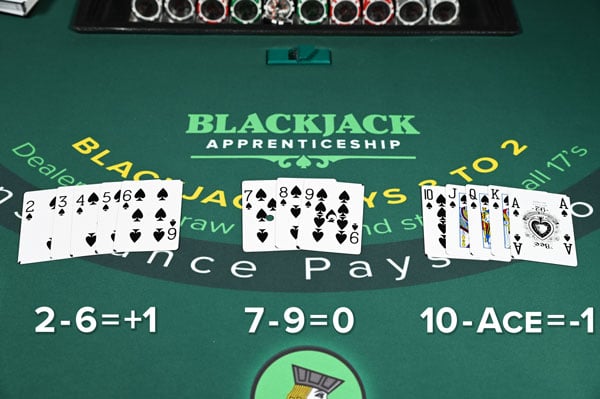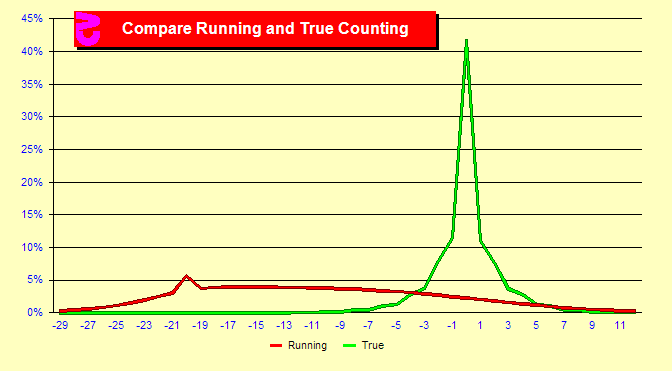Running Count Vs True Count
Learn a very easy system for counting cards in Blackjack called Hi/Lo. You can learn to count cards in 10 minutes or less!
- True Count Vs Running Count. The Running Count is only going to tell the player whether there are fewer or more high cards in the deck compared to the.
- I'm doing a comparison of Dijkstra's and BFS, on both adjacency lists and adjacency matrices. I'm testing all four variations as shortest path algorithms, and clocking their running time over unwei.
The two easiest counting systems are Hi-Lo and Hi-Opt I. Both systems assign +1 to 3,4,5,6 and -1 to T,J,Q,K. Both systems do not count 7,8 and 9. Hi-Lo assigns +1 to 2 and -1 to A while Hi-Opt I assigns 0 to both.
Here are these systems in detail:
Hi-Lo
2,3,4,5,6: +1
7,8,9: 0
T,J,Q,K,A: -1
Hi-Opt I
3,4,5,6: +1
2,7,8,9,A: 0
T,J,Q,K: -1
The true count is calculated by divided the running count by the number of decks remaining.
Here’s a simple example. You’re playing the first hand of an 8 deck shoe and it is just you and the dealer. You’re dealt 6,4 and the dealer has 7 showing. You hit, get a J and stand on 20. The dealer turns over the card next to his 7 and shows that it is a 6. He hits his 13 and draws a 5 for an 18 giving you the win on this first hand.
Using the Hi-Lo system, what is the count?
You
6: +1
4: +1
J: -1
Dealer
7: 0
6: +1
5: +1
Running Total: +3
There are still close to 8 decks so the true count is 3/8.
Blackjack charts are meant for when the true count is close to zero. When casinos use 8 deck shoes and reshuffle before getting near the end of the shoe, the true count tends to stay near 0 (remember, the true count is the running count divided by the number of decks left).
Chart strategy differences are more important when the count is positive than when the count is negative. This is because we’re betting more money when the count is positive but we’re betting the minimum or taking a break when the count is negative.
The World’s Greatest Blackjack Book says to stand on 16 vs T (instead of hitting) when we can’t surrender and the true count is greater than 0.
The book also has the following strategy changes when the true count is higher than 1:
- Stand on 12 vs 3.
- Stand on A,7 vs A.
- Double 11 vs A (already true when dealer hits soft 17).
- Double 9 vs 2.
- Double A,8 vs 6 (already true when dealer hits soft 17).
- Double A,8 vs 5.
- Double A,7 vs 2 (already true when dealer hits soft 17).
- Double A,3 vs 4.
- Split 7,7 vs 8.
Note that the figures in this book are based on just 4 decks so be careful. Also, the book uses Hi-Opt I where Aces and Deuces are not counted.
Counting cards can really help you when playing live dealer online blackjack! You can play live blackjack at Betonline! Learn more at LiveDealerSites.
Check out Roulette Betting System for a cool betting strategy and test it yourself for free.
Play blackjack at the Miami Club Casino and play for free! Check out the available Miami Club no deposit bonus codes at https://usacasinobonuscode.com/miami-club-bonus-code/.
Blackjack Running Count, True Count, and Player Advantage Simulator
The following Excel spreadsheet simulates the dealing of 6 decks of cards at random. It graphs the running count, true count, and player advantage as the cards are dealt. When counting cards, you should make your minimum waiting bet when the player advantage is zero or negative. When the player advantage goes positive, you should bet a percentage of your bankroll equal to your player advantage, according to the Kelly Criterion. Instructions
- If necessary, bring the two graphs into view using the scroll bar:
Running count / True count
Player advantage % - To deal another 6 decks and update the graphs, first click to select any cell (such as K4), then press the F9 key. Press F9 again for another 6 decks. If your device does not have an F9 key, reload the page.
Notes
- To see graphs for a single-deck or double-deck game, click the 'Single' or '2 decks' tab at the bottom of the window.
- If you accidentally modify a cell value or formula, you might ruin the graph. To fix it, reload the web page.
- Another way to deal 6 decks is to click the Refresh icon( )at the bottom of the spreadsheet window.
Instructional Videos
Running Count | True Count | Two Decks | Six Decks 3:2 6:5 |
Running Count / True Count Graph
The running count (grey graph line) keeps track of the number of high vs. low cards using the classic Hi-Lo count strategy, where cards 2-3-4-5-6 have a value of +1, cards 7-8-9 have a value of 0, and cards 10-J-Q-K-A have a value of -1. The count at the beginning is zero. The count at the end is also zero, because the numbers of low and high cards are balanced.As the cards are dealt, the count randomly varies between positive and negative values, depending on whether more low or high cards are dealt out. The graph is equally likely to be above or below zero.
The true count (blue graph line in top graph) is the running count divided by the number remaining decks to be dealt. This adjusts the running count to determine the true effect, fraction-wise, on the probability of dealing out high or low cards from the remaining decks. For this reason, I prefer to call this the 'true-effect count' or 'one-deck equivalent count.'
Player Advantage Graph
The player advantage graph shows your advantage as a percentage of your bet. For example, when your advantage is 1.00 percent and you make a $20 bet, your average win on that bet will be 20 cents. Not a huge advantage by any means! You have an advantage when the graph goes above zero, as indicated by the solid black horizontal line. The dashed horizontal
 purple line - - - - - - - represents the basic strategy player edge for a typical good 6-deck game, -0.6 percent. The player advantage graph is centered on the dashed purple line; it is equally likely to be above or below this line. Thus, you play at a disadvantage more than half the time.
purple line - - - - - - - represents the basic strategy player edge for a typical good 6-deck game, -0.6 percent. The player advantage graph is centered on the dashed purple line; it is equally likely to be above or below this line. Thus, you play at a disadvantage more than half the time.  The player advantage graph is shown solid for the first 4.5 decks and dashed for the remaining 1.5 decks. This is because most casinos shuffle when there are 1.5 decks remaining. That means you will not have any opportunities to make bets in the dashed portions of the graph.
The player advantage graph is shown solid for the first 4.5 decks and dashed for the remaining 1.5 decks. This is because most casinos shuffle when there are 1.5 decks remaining. That means you will not have any opportunities to make bets in the dashed portions of the graph. You can place a bet only at the end of each round. At an uncrowded table, maybe 12 or so cards are dealt in each round, on average. Therefore, I've spaced the card number labels at the bottom at intervals of 12. These represent (approximately) the intervals at which you can place bets.
Cell N2 contains the basic strategy player advantage at the start of the game, -0.60 percent by default. For a game that pays only 6:5 on blackjack, the player advantage is worse by 1.4 percent. To see the effect of a 6:5 payoff, enter -2.00 into cell N2.
Player Advantage Pie Chart
The pie chart shows the relative amounts of time that you play at an advantage, at a disadvantage, and even with the casino. A player edge between -0.25 and +0.25 percent is considered even. The pie chart applies only to the part of the graph before the shuffle. For More Information
For more about card counting, see Does Card Counting Really Work? (web page or YouTube video)Or see the whole YouTube playlist 'Easy basic strategy, house edge, and card counting'
For another good introduction to card counting, see The Wizard of Odds website
Running Count Vs True Count
For a very good and free online book on blackjack, see ModernBlackjack, An Illustrated Guide to Blackjack Advantage Play, by Norman Wattenberger
For a detailed technical look at the game, see Wattenberger's How Blackjack Works